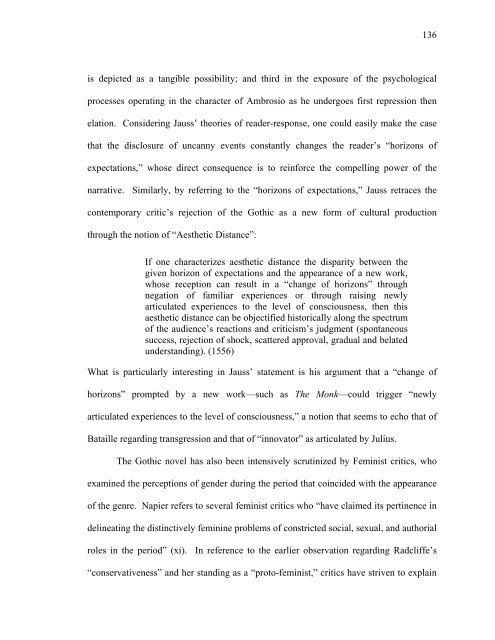Untitled - Sexey's School Moodle
Untitled - Sexey's School Moodle
Untitled - Sexey's School Moodle
You also want an ePaper? Increase the reach of your titles
YUMPU automatically turns print PDFs into web optimized ePapers that Google loves.
is depicted as a tangible possibility; and third in the exposure of the psychological<br />
processes operating in the character of Ambrosio as he undergoes first repression then<br />
elation. Considering Jauss’ theories of reader-response, one could easily make the case<br />
that the disclosure of uncanny events constantly changes the reader’s “horizons of<br />
expectations,” whose direct consequence is to reinforce the compelling power of the<br />
narrative. Similarly, by referring to the “horizons of expectations,” Jauss retraces the<br />
contemporary critic’s rejection of the Gothic as a new form of cultural production<br />
through the notion of “Aesthetic Distance”:<br />
If one characterizes aesthetic distance the disparity between the<br />
given horizon of expectations and the appearance of a new work,<br />
whose reception can result in a “change of horizons” through<br />
negation of familiar experiences or through raising newly<br />
articulated experiences to the level of consciousness, then this<br />
aesthetic distance can be objectified historically along the spectrum<br />
of the audience’s reactions and criticism’s judgment (spontaneous<br />
success, rejection of shock, scattered approval, gradual and belated<br />
understanding). (1556)<br />
What is particularly interesting in Jauss’ statement is his argument that a “change of<br />
horizons” prompted by a new work—such as The Monk—could trigger “newly<br />
articulated experiences to the level of consciousness,” a notion that seems to echo that of<br />
Bataille regarding transgression and that of “innovator” as articulated by Julius.<br />
136<br />
The Gothic novel has also been intensively scrutinized by Feminist critics, who<br />
examined the perceptions of gender during the period that coincided with the appearance<br />
of the genre. Napier refers to several feminist critics who “have claimed its pertinence in<br />
delineating the distinctively feminine problems of constricted social, sexual, and authorial<br />
roles in the period” (xi). In reference to the earlier observation regarding Radcliffe’s<br />
“conservativeness” and her standing as a “proto-feminist,” critics have striven to explain



